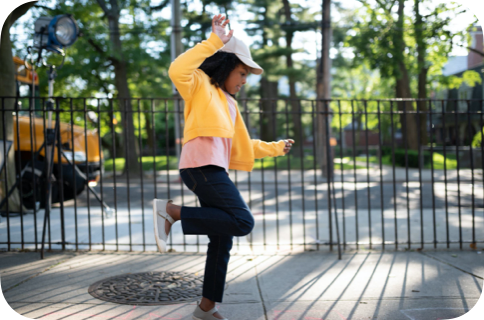How the
treatment process works
It takes time for the body to learn how to tolerate small amounts of peanut protein with no more than mild allergic symptoms. Slowly consuming more and more of an allergen over a long period of time is part of a process called oral immunotherapy or OIT. Treatment with PALFORZIA starts with a build-up process that takes place over the course of about six months with increasing dose levels and then continues with a daily Maintenance Dose.

Getting ready
for your child’s first treatment
Your child’s first dosing appointment is called the Initial Dose Escalation (IDE) visit. The IDE will take at least four hours, so it is a good idea to plan ahead.
WHAT
HAPPENS
- 1
Check in
Your child's allergist will discuss the treatment process, review the Medication Guide, take your child’s vital signs, and confirm that your child is enrolled in the REMS program for PALFORZIA.
- 2
First dose and observation
Your child's allergist will give your child the first dose of PALFORZIA and wait 20–30 minutes to evaluate any potential allergic reactions and determine how to proceed.
- 3
Dose escalation and observation
There will be four more doses, for a total of five. After each dose, your child will wait 20–30 minutes to make sure doses can continue. However, after the final dose, your child’s allergist will observe your child for 60 minutes.
Should an allergic reaction occur, your child’s allergist will treat it accordingly, which may also include discontinuing PALFORZIA.
WHAT
TO BRING
Here is a list of items you may want to bring to the IDE appointment. Check with your child's allergist to make sure you have everything that their office might require as well.
- Insurance card
- List of other medications your child may be taking
- Injectable epinephrine
- Books, games, toys, etc.
- Make a plan with your child and bring activities that will keep you both entertained
CONTINUING TREATMENT
AT HOME
Once your child has completed the Initial Dose Escalation visit, bring your child back to the allergist’s office, preferably the next day, for initiation of Up-Dosing at a 3 mg dose. The Up-Dosing phase typically lasts six months, with an initial visit to the allergist’s office during each dosage increase, followed by two weeks of daily at-home dosing treatment.
Your child’s safety is our highest priority, so we put together this list of “Do’s and Don’ts” to help you establish your home treatment routine in the safest possible way.
For detailed information about how to prepare and administer PALFORZIA at home, be sure to talk to your child’s allergist or refer to the Treatment Handbook for detailed dosing guidance.
 Continue to have your child carry their injectable epinephrine.
Continue to have your child carry their injectable epinephrine. Have your child take their dose of PALFORZIA with a meal at the same time every day; mix it well into a few spoonfuls of a soft food, such as applesauce, yogurt, or pudding, that’s either cold or at room temperature (not hot and not liquid). Talk to your child's allergist if you have any questions.
Have your child take their dose of PALFORZIA with a meal at the same time every day; mix it well into a few spoonfuls of a soft food, such as applesauce, yogurt, or pudding, that’s either cold or at room temperature (not hot and not liquid). Talk to your child's allergist if you have any questions. Keep an eye on your child for one hour after they take their dose, in case there are any signs of an allergic reaction.
Keep an eye on your child for one hour after they take their dose, in case there are any signs of an allergic reaction. Keep PALFORZIA in the refrigerator.
Keep PALFORZIA in the refrigerator. If your child misses taking PALFORZIA, contact your child's allergist. Do not take additional doses on the same day to make up for missed doses.
If your child misses taking PALFORZIA, contact your child's allergist. Do not take additional doses on the same day to make up for missed doses. Be aware of certain conditions that may increase the likelihood of an allergic reaction, including having an illness such as a viral infection, being very tired or missing sleep, being stressed, having a menstrual period, exercising, taking certain pain medications such as aspirin or ibuprofen, or drinking alcohol.
Be aware of certain conditions that may increase the likelihood of an allergic reaction, including having an illness such as a viral infection, being very tired or missing sleep, being stressed, having a menstrual period, exercising, taking certain pain medications such as aspirin or ibuprofen, or drinking alcohol.
 Do not have your child eat peanuts or peanut products as part of their diet.
Do not have your child eat peanuts or peanut products as part of their diet. Do not give your child their daily dose of PALFORZIA on the day of an appointment since they will be receiving some from your child’s allergist.
Do not give your child their daily dose of PALFORZIA on the day of an appointment since they will be receiving some from your child’s allergist. Do not take more than one dose of PALFORZIA in a single day.
Do not take more than one dose of PALFORZIA in a single day. Do not give any more doses on the same day to make up if your child has missed a dose of PALFORZIA. Instead, contact your child's allergist for next steps in continuing treatment.
Do not give any more doses on the same day to make up if your child has missed a dose of PALFORZIA. Instead, contact your child's allergist for next steps in continuing treatment. Do not let your child swallow the capsule or inhale the powder.
Do not let your child swallow the capsule or inhale the powder. Do not give your child PALFORZIA if they are very hot or have just participated in any strenuous physical activity, like a game or sport, and still have a high heart rate.
Do not give your child PALFORZIA if they are very hot or have just participated in any strenuous physical activity, like a game or sport, and still have a high heart rate. Do not let your child participate in sports or other strenuous physical activity or take a hot bath or shower within three hours after taking PALFORZIA.
Do not let your child participate in sports or other strenuous physical activity or take a hot bath or shower within three hours after taking PALFORZIA.
Is your child ready for the Next Phase?
If you reach the PALFORZIA Maintenance phase, congratulations! This is an exciting milestone. Your child won’t need to consume higher doses after reaching the Maintenance phase and can continue taking the same daily dose at home.
Remember that PALFORZIA is not a cure for peanut allergy, so avoiding peanuts and always carrying injectable epinephrine are still required for treatment. Daily Maintenance is required to maintain the effect of PALFORZIA.

Need more
information?
Download our Treatment Handbook for more details on the treatment process. We also have a secondary caregivers guide you can share with teachers, babysitters, family members, and anyone else who may need to know about peanut allergy treatment.





